THE RACE: How Little We Know About Lions!! (antlions, that is)
A recurrent theme in our work in the Republic of São Tomé and Príncipe is the continuous reminder of how little we and the 160,000 citizens of these fragile little islands know about the unique biology found here. I have already told you that when we first arrived, there were but four species of mushrooms listed from São Tomé and none from Príncipe; we now have at least 180, and the first ever recorded from Príncipe (75), the older of the two islands. Many of these are species new to science and are being described for the first time; this is a huge jump in the island biodiversity list and there is much more to come.
During our first expedition in 2001 (GG I), we were interviewed twice by the local television station in São Tomé. In the second interview two weeks after our arrival, I had the whole gang prepared to show some of the specimens we had collected. When we showed him the scorpions, the reporter, Gui Gui, went nuts! Neither he nor any other citizen we have spoken to since, has ever seen nor heard of a scorpion. And yet they are quite common at night (along with numerous geckos and crabs) on the basalt cliffs of the northwestern shore of the island near Laguna Azul.
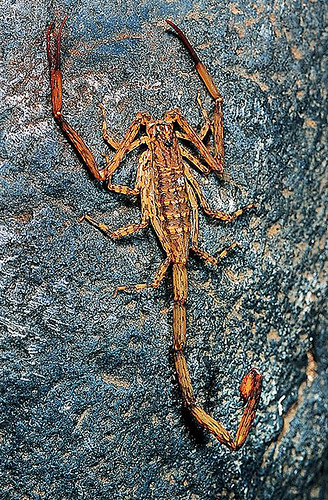
Isometrus, widespread tropical. Sao Tome (D. Lin phot) GG I
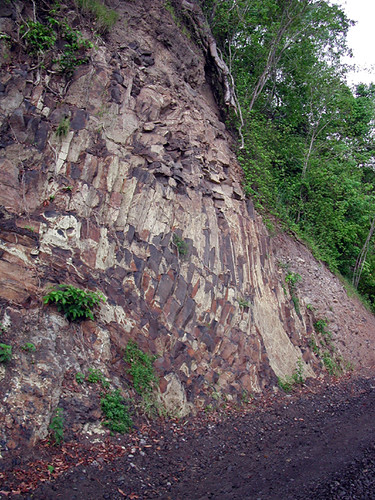
Basalt Cliffs near Laguna Azul, Sao Tome. GG I (J.Ledyard phot)
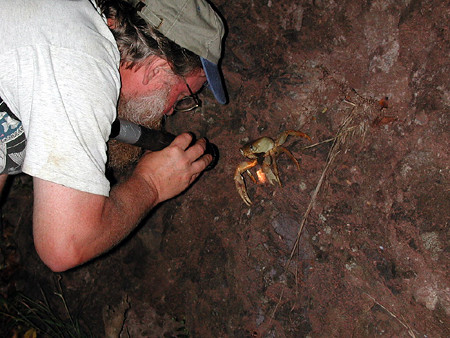
Jens Vindum confronts crab on basalt cliffs. Sao Tome. GG I (RCD phot)
I am told that if the new hotel project at Laguna Azul becomes a reality, the coastal area will become inaccessible to local traffic, and the road will be re-routed higher, some 3 km through the dry, north end of the island from Laguna Azul to Neves. What we call “Shipwreck Cove” (Praia Mutamba), one of our favorite study sites and the location of some remnant dry forest will become the marina for the new hotel.
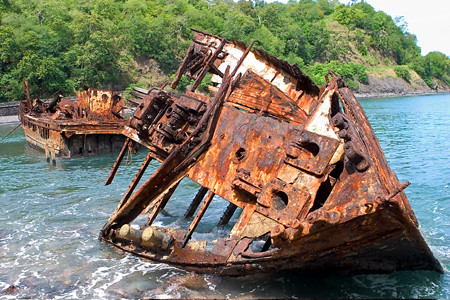
Praia Mutamba, Sao Tome. note basalt cliffs in background. GG III (weckerphoto)
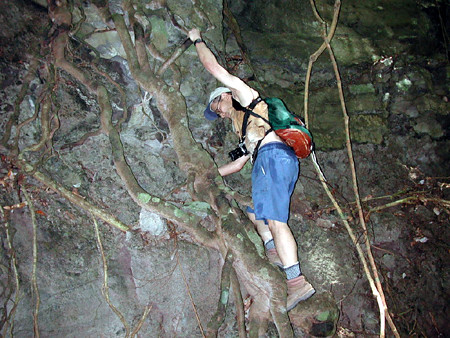
Dr. Tomio Iwamoto negotiates old dry forest. Praia Mutambo, Sao Tome GG I (RCD phot)
Yet another example of how little we know about these islands can be found in the insect order Neuroptera. Neuropterans are world-wide and include the lacewings, mantis flies and antlions. As kids, we western North Americans know antlion larvae as “doodlebugs”, the little critters that form funnels in the ground. One of the world’s leading experts on the Neuroptera is the Academy’s Dr. Norm Penny,who was with us on both GG I in 2001 and GG II in 2006.

Dr. Norm Penny with a malaise trap, Principe. GG II (D. Lin phot)
Prior to GG I, there were only four species of neuropterans known from São Tomé and Príncipe from as many specimens. All were lacewings; antlions had never been recorded from either island. At the end of GG I, Norm had about 370 specimens, representing 14 species in three families!

Apochrysa leptalea Sao Tome. GG I (D. Lin phot)

Borniochrysa squamosa Sao Tome. GG I (D. Lin phot)
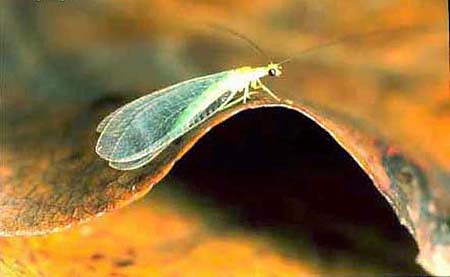
Ceratochrysa sp. Sao Tome. GG I (D. Lin phot)

Glenochrysa sp. Sao Tome. GG I (D. Lin phot)
The distribution of these critters throughout the Gulf of Guinea archipelago refelects an old island biogeographic principe: the number of species supportable on an oceanic island can be predicted by the island area and its distance from the mainland. As you can see below, island area seems more important in this case. One might predict that because Príncipe is closer to the mainland, it should support more species than São Tomé. But, put simply, the larger, more variable an island’s topography, the greater number of niches (read “jobs”) are available to be filled by colonizers.
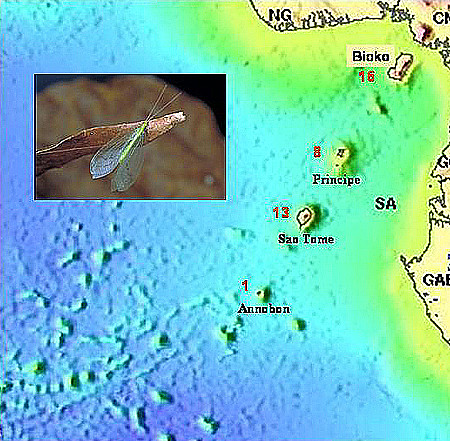
As I mentioned above, antlions (Myrmeleon) are close relatives of lacewings and had not been recorded on either island prior to GG I. Antlion larvae dig funnel-shaped pits and hide at the bottom, partially buried in sand and waiting for an unsuspecting ant or other arthropod to slide into the pit, whereupon the larva or “doodlebug” kills and eats it. We first noticed these pits across the road from where we were staying in São Tomé in 2001.

Antlion (doodlebug) pits. Sao Tome GG I (D. Lin phot)
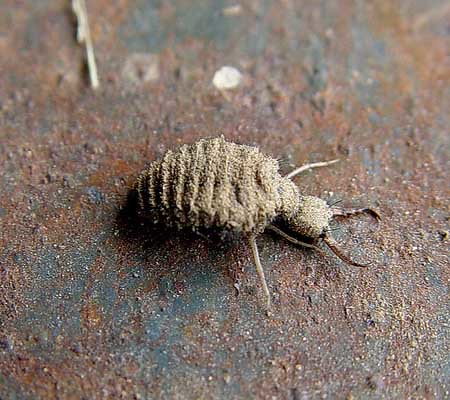
antlion larva (doodlebug) exposed (J. Robinson phot)

A doodlebug lies in wait at the bottom of his pit. (WWW phot)
Now, the curious thing is that one does not have to capture the winged adults in order to study antlions. It turns out that the larvae are very hardy, and you only need to winkle them out of the pits, put them in a small vial of sand, and they become quiescent, surviving for long periods of time. Norm can then raise them to adulthood later in his doodlebug lab.
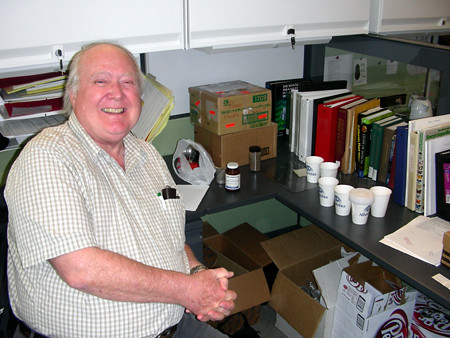
Dr. Penny in his antlion lab (note cups) (RCD phot.)

First adult Sao Tome antlion raised in lab. New record for Sao Tome. (D. Lin phot)
Norm puts the newly arrived larvae in styrfoam cups, they revive, feed on tiny crickets he provides, and then pupate. He then covers the cup, because, obviously, the adult will be winged. We have been quite excited because we brought back the first ever Príncipe antlion larvae and one pupated in Dr. Penny’s lab.
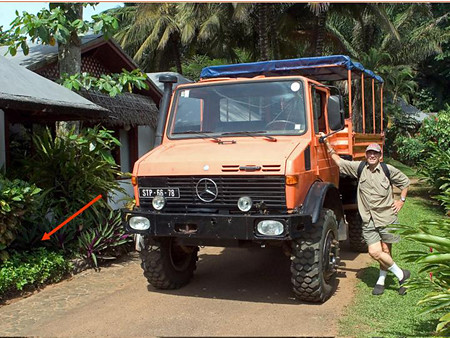
First Principe antlion locality. Bombom Island. GG III (weckerphoto)

Note the doodlebug has pupated. (RCD phot)

The hatching! Note hole in the old pupa ball. (RCD photo)

First Principe antlion hatched in our lab and a new record for Principe (RCD phot)
Very exciting. Norm says both are species of Myrmeleon but whether they are the same species or different species has yet to be determined… This baseline work we do takes time. But again, our job is to discover, analyze (understand) and describe. We cannot preserve what we do not know.
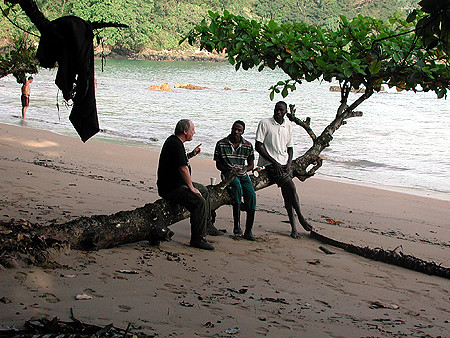
Dr. Norm Penny on Praia Agulhas, Principe. GG I (RCD phot)
Here is our usual “parting shot”:

The "race" on Sao Tome
PARTNERS
We gratefully acknowledge the support of the Research Investment Fund of the California Academy of Sciences, the Société de Conservation et Développement (SCD) for logistics, ground transportation and lodging, STePUP of Sao Tome http://www.stepup.st/ and especially the generosity of three private individuals, George F. Breed, Gerry F. Ohrstrom and Timothy M. Muller, for making GG III possible.